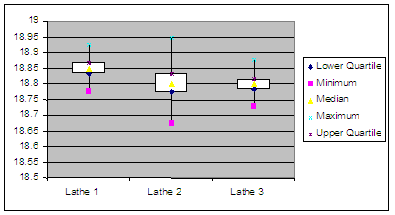
They take up less space. Box and whisker plots use less space when compared to other types of data graphs and charts. If these numbers are far away from the averages, you can use dots to represent them.īox and whisker plots offer the following advantages: The highest and lowest numbers in your data can sometimes be outliers. Whiskers are lines that identify numbers outside of the average results. You draw boxes to connect the first quartile to the third quartile, with the boxes representing the averages of your data.

Dividing the information in this way helps you input the data onto the plot.

When you create a box and whisker plot, separate your data into quarters, called quartiles. It also helps determine outliers in your data. It takes a large amount of numbers and simplifies them into averages so data is easily understood. Related: Research Associate Resumes What is a box and whisker plot?Ī box and whisker plot, or box plot, is a diagram that visually displays data. In this article, we explain the purpose of box and whisker plots and the steps that you can take to create one.
#WHEN TO USE BOX AND WHISKER PLOT HOW TO#
Once you learn how to create box and whisker plots and how to interpret them, you may find your data to be more digestible. Box and whisker plots are one method of organizing data that makes information easier to consume. Here, 1.5 IQR above the third quartile is 88.5 ☏ and the maximum is 81 ☏.A large amount of data can be best understood through a visual representation. The upper whisker boundary of the box-plot is the largest data value that is within 1.5 IQR above the third quartile.

Minimum ( Q 0 or 0th percentile): the lowest data point in the data set excluding any outliers.Same box-plot with whiskers drawn within the 1.5 IQR valueĪ boxplot is a standardized way of displaying the dataset based on the five-number summary: the minimum, the maximum, the sample median, and the first and third quartiles. Box plots can be drawn either horizontally or vertically.įigure 3. In addition, the box-plot allows one to visually estimate various L-estimators, notably the interquartile range, midhinge, range, mid-range, and trimean.

The spacings in each subsection of the box-plot indicate the degree of dispersion (spread) and skewness of the data, which are usually described using the five-number summary. Outliers that differ significantly from the rest of the dataset may be plotted as individual points beyond the whiskers on the box-plot.īox plots are non-parametric: they display variation in samples of a statistical population without making any assumptions of the underlying statistical distribution (though Tukey's boxplot assumes symmetry for the whiskers and normality for their length). In addition to the box on a box plot, there can be lines (which are called whiskers) extending from the box indicating variability outside the upper and lower quartiles, thus, the plot is also termed as the box-and-whisker plot and the box-and-whisker diagram. In descriptive statistics, a box plot or boxplot is a method for graphically demonstrating the locality, spread and skewness groups of numerical data through their quartiles. Box plot of data from the Michelson experiment


 0 kommentar(er)
0 kommentar(er)
